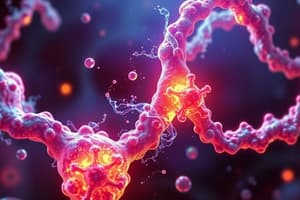Podcast
Questions and Answers
How does the 'induced fit' model describe the interaction between an enzyme and its substrate?
How does the 'induced fit' model describe the interaction between an enzyme and its substrate?
- The substrate forces the enzyme to maintain a static shape throughout the reaction.
- The enzyme changes its conformation to accommodate the substrate, enhancing binding. (correct)
- The enzyme and substrate have perfectly complementary shapes from the start.
- The enzyme rigidly binds to any substrate, ensuring reaction specificity.
What is the functional consequence of an enzyme's specificity for a particular reaction?
What is the functional consequence of an enzyme's specificity for a particular reaction?
- It ensures that the enzyme only catalyzes one specific type of reaction. (correct)
- It increases the enzyme's ability to bind to any molecule within the cell.
- It allows the enzyme to catalyze a wide range of reactions on different substrates.
- It enables the enzyme to function effectively at any temperature or pH level.
Which statement accurately describes the role of inorganic catalysts compared to enzymes?
Which statement accurately describes the role of inorganic catalysts compared to enzymes?
- Inorganic catalysts work under a narrower range of conditions.
- Enzymes are generally more specific than inorganic catalysts. (correct)
- Enzymes do not require specific conditions to function, unlike inorganic catalysts.
- Inorganic catalysts are more specific than enzymes.
What is the primary effect of increasing temperature on enzyme-catalyzed reaction rates?
What is the primary effect of increasing temperature on enzyme-catalyzed reaction rates?
How do changes in pH affect enzyme activity?
How do changes in pH affect enzyme activity?
How does increasing enzyme concentration affect the rate of a reaction, assuming substrate is abundant?
How does increasing enzyme concentration affect the rate of a reaction, assuming substrate is abundant?
What happens to the reaction rate as you increase the concentration of substrate, assuming the enzyme concentration stays consistent?
What happens to the reaction rate as you increase the concentration of substrate, assuming the enzyme concentration stays consistent?
What is meant by the term 'saturation' in the context of enzyme kinetics?
What is meant by the term 'saturation' in the context of enzyme kinetics?
How do allosteric effectors regulate enzyme activity?
How do allosteric effectors regulate enzyme activity?
What distinguishes allosteric enzymes from other enzymes?
What distinguishes allosteric enzymes from other enzymes?
How does a positive allosteric effector influence enzyme activity?
How does a positive allosteric effector influence enzyme activity?
Differentiate between reversible and irreversible enzyme inhibitors with respect to their mechanism of action:
Differentiate between reversible and irreversible enzyme inhibitors with respect to their mechanism of action:
How does a competitive inhibitor affect enzyme activity?
How does a competitive inhibitor affect enzyme activity?
How can competitive inhibition be overcome?
How can competitive inhibition be overcome?
How does a non-competitive inhibitor reduce enzyme activity?
How does a non-competitive inhibitor reduce enzyme activity?
What distinguishes non-competitive inhibitors from competitive inhibitors?
What distinguishes non-competitive inhibitors from competitive inhibitors?
What is the result of diisopropyl fluorophosphate (DFP) irreversibly inhibiting acetylcholinesterase?
What is the result of diisopropyl fluorophosphate (DFP) irreversibly inhibiting acetylcholinesterase?
How do enzymes increase the rate of biochemical reactions?
How do enzymes increase the rate of biochemical reactions?
What is the role of the active site in enzyme catalysis?
What is the role of the active site in enzyme catalysis?
What is the key characteristic that defines enzymes as biological catalysts?
What is the key characteristic that defines enzymes as biological catalysts?
What term describes the protein part of an enzyme that requires a cofactor to be active?
What term describes the protein part of an enzyme that requires a cofactor to be active?
What constitutes a holoenzyme?
What constitutes a holoenzyme?
How do coenzymes assist in enzymatic reactions?
How do coenzymes assist in enzymatic reactions?
Why are vitamins, particularly B vitamins, important for enzyme function?
Why are vitamins, particularly B vitamins, important for enzyme function?
What is the role of transferases in enzyme catalysis?
What is the role of transferases in enzyme catalysis?
What kind of reaction do hydrolases catalyze?
What kind of reaction do hydrolases catalyze?
What is that function that lyases perform on chemical bonds?
What is that function that lyases perform on chemical bonds?
What is the primary function of isomerases?
What is the primary function of isomerases?
What is the function of ligases?
What is the function of ligases?
Flashcards
What is the active site?
What is the active site?
Small region of the enzyme where catalysis occurs.
What is substrate specificity?
What is substrate specificity?
Enzyme's ability to bind only one specific substrate.
What is induced fit model?
What is induced fit model?
Interaction between substrate and enzyme induces a shape change.
What is reaction specificity?
What is reaction specificity?
Signup and view all the flashcards
What are oxidoreductases?
What are oxidoreductases?
Signup and view all the flashcards
What are transferases?
What are transferases?
Signup and view all the flashcards
What are hydrolases?
What are hydrolases?
Signup and view all the flashcards
What are lyases?
What are lyases?
Signup and view all the flashcards
What are isomerases?
What are isomerases?
Signup and view all the flashcards
What are ligases?
What are ligases?
Signup and view all the flashcards
What is enzymatic activity?
What is enzymatic activity?
Signup and view all the flashcards
What is optimal temperature?
What is optimal temperature?
Signup and view all the flashcards
What is optimal pH?
What is optimal pH?
Signup and view all the flashcards
What is lowering activation energy?
What is lowering activation energy?
Signup and view all the flashcards
What are allosteric effectors?
What are allosteric effectors?
Signup and view all the flashcards
What is an enzymatic inhibitor?
What is an enzymatic inhibitor?
Signup and view all the flashcards
What are irreversible inhibitors?
What are irreversible inhibitors?
Signup and view all the flashcards
What are competitive inhibitors?
What are competitive inhibitors?
Signup and view all the flashcards
What are non-competitive inhibitors?
What are non-competitive inhibitors?
Signup and view all the flashcards
What are coenzymes?
What are coenzymes?
Signup and view all the flashcards
What are activators?
What are activators?
Signup and view all the flashcards
What is an apoenzyme?
What is an apoenzyme?
Signup and view all the flashcards
What is a holoenzyme?
What is a holoenzyme?
Signup and view all the flashcards
What is a reaction profile?
What is a reaction profile?
Signup and view all the flashcards
What is a exergonic reaction?
What is a exergonic reaction?
Signup and view all the flashcards
What is a endergonic reaction?
What is a endergonic reaction?
Signup and view all the flashcards
Study Notes
- Gli enzimi hanno un'elevata specificità sia nei confronti del substrato su cui agiscono, sia nei confronti del tipo di reazione catalizzata.
Specificità di substrato
- La specificità di substrato dipende dal sito attivo dell'enzima.
- Il sito attivo è una piccola regione dell'enzima, dalla configurazione ben definita, dove si trovano le catene laterali degli amminoacidi che partecipano alla catalisi e il coenzima, se presente.
- La specificità di un enzima dipende dalla configurazione spaziale del sito attivo per legare un unico substrato.
- L'interazione tra substrato ed enzima è spiegata dal modello dell'adattamento indotto: l'interazione innesca un cambiamento conformazionale nell'enzima per adattarsi al substrato, formando il complesso enzima-substrato ES.
Specificità di reazione
- La specificità di reazione è legata al tipo di reazione catalizzata: un enzima che catalizza una reazione di idrolisi non può catalizzare una reazione di ossidazione sullo stesso substrato.
- Gli enzimi sono classificati in sei classi in base al tipo di reazione catalizzata, con il nome che include un prefisso indicante il tipo di reazione e il suffisso "-asi".
- Le ossidoreduttasi catalizzano reazioni di ossidazione e riduzione.
- Le transferasi catalizzano il trasferimento di gruppi funzionali tra due molecole.
- Le idrolasi catalizzano reazioni di idrolisi in cui i legami covalenti si rompono con l'aggiunta di acqua.
- Le liasi catalizzano reazioni di rottura di un doppio legame o di formazione di un doppio legame.
- Le isomerasi catalizzano il trasferimento di atomi all'interno di una stessa molecola, formando isomeri.
- Le ligasi catalizzano reazioni di sintesi tra due molecole con formazione di un legame.
Attività enzimatica
- In assenza di enzimi, le reazioni del metabolismo cellulare sarebbero troppo lente per supportare le funzioni metaboliche.
- Gli enzimi aumentano la velocità di reazione diminuendo l'energia di attivazione, quindi l'attività enzimatica è la quantità di substrato trasformato in prodotto per unità di tempo.
- L'attività enzimatica è influenzata da fattori come temperatura e pH, oltre che dalle concentrazioni di enzima e substrato
Effetto della temperatura
- Tutte le reazioni chimiche, incluse quelle enzimatiche, accelerano con l'aumento della temperatura.
- A temperature elevate, i legami che stabilizzano la struttura secondaria e terziaria delle proteine si rompono, causando la denaturazione e la perdita di attività catalitica.
- La velocità aumenta fino al raggiungimento di un valore determinato, al di sopra del quale la velocità diminuisce a causa della progressiva denaturazione dell'enzima.
- La temperatura alla quale corrisponde la massima attività catalitica è chiamata temperatura ottimale.
- Nelle cellule umane, la temperatura ottimale per gli enzimi è di circa 37 °C.
- Per i batteri termofili, che vivono in ambienti caldi, la temperatura ottimale per gli enzimi può arrivare fino a 80 °C.
Effetto del pH
- L'attività catalitica degli enzimi dipende anche dal pH della soluzione, che influenza la conformazione del sito attivo e l'interazione enzima-substrato.
- La maggior parte degli enzimi digestivi ha un pH ottimale tra 6.0 e 8.0.
- La chimotripsina, un enzima pancreatico, è attiva in ambiente basico (pH 7.8).
- La pepsina, prodotta dalle ghiandole gastriche che idrolizza le proteine, ha un pH ottimale di 1.5.
- Il valore del pH della soluzione al quale corrisponde la massima attività catalitica si chiama pH ottimale.
Effetto della concentrazione dell'enzima
- L'attività enzimatica è direttamente proporzionale alla concentrazione dell'enzima, quando il substrato è in eccesso.
- Aumentando la concentrazione dell'enzima, aumentano i siti attivi disponibili per legarsi al substrato.
Effetto della concentrazione del substrato
- All'aumentare della concentrazione del substrato, la velocità di reazione aumenta, raggiunge un valore massimo, e poi rimane costante.
- Quando tutti i siti attivi degli enzimi sono saturati dal substrato, l'enzima è saturo, e la velocità si stabilizza.
Regolazione dell'attività enzimatica
- L'attività degli enzimi può essere modulata per rispondere alle esigenze metaboliche cellulari.
- Altri meccanismi di regolazione sono gli effettori allosterici e gli inibitori enzimatici.
Effettori allosterici
- Gli effettori allosterici sono molecole che si legano, non covalentemente, all'enzima, inducendo un cambiamento conformazionale.
- Gli effettori positivi aumentano la capacità del sito attivo di legarsi al substrato.
- Gli effettori negativi diminuiscono la capacità del sito attivo di legarsi al substrato.
- Un enzima la cui attività è influenzata da un effettore allosterico è chiamato enzima allosterico.
Inibitori enzimatici
- Gli inibitori enzimatici sono molecole che si combinano con gli enzimi interferendo con la loro attività catalitica, e si dividono in irreversibili e reversibili.
- Gli inibitori irreversibili modificano il sito attivo dell'enzima in modo che non possa più legare il substrato, legandosi all'enzima in modo stabile e permanente.
- Un esempio è il diisopropil fluorofosfato (DFP), che inibisce l'acetilcolinesterasi formando un legame covalente con la serina nel sito attivo.
- Gli inibitori reversibili si legano all'enzima, riducendone l'attività catalitica, e si distinguono in competitivi e non competitivi.
- Gli inibitori competitivi hanno una forma simile al substrato, e si legano al sito attivo con legami non covalenti, competendo con il substrato per il legame con l'enzima.
- Gli inibitori non competitivi si legano all'enzima in una regione diversa dal sito attivo, causando un cambiamento conformazionale che impedisce al sito attivo di legarsi al substrato.
Studying That Suits You
Use AI to generate personalized quizzes and flashcards to suit your learning preferences.




